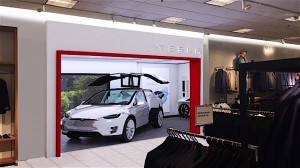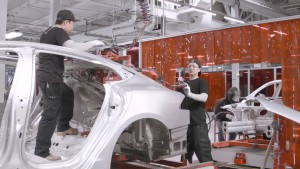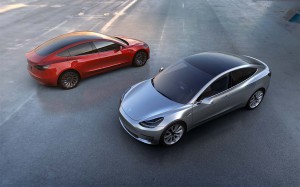Tesla got a jump on the rest of the auto industry, reporting late Sunday that it set new production and delivery records for the first quarter of the year.
That comes as particular good news for the Silicon Valley manufacturer of electric vehicles, Tesla stretching its finances as it prepares for the launch of the all-new Model 3 sedan later this year. Sales had slumped during the final quarter of 2017 due to a mix of production snags, including the shift to a new version of the maker’s Autopilot system.
Tesla was forced to return to Wall Street late in the January-March quarter, raising about $1.4 billion in a new stock offering. Investors responded positively, despite CEO Elon Musk’s warning that the maker’s finances were “getting very close to the edge.”
The Model 3 will go into production in July, according to Musk, though it will likely be months before customers begin taking delivery of Tesla’s first mainstream battery-electric sedan.
For now, the maker continues to rely on two higher-priced models delivering 13,450 Model S sedans during the final three months of 2016, along with 11,550 Model X battery-SUVs. The January-March numbers would have been even stronger but for transportation and other delays that meant about 2,750 vehicles didn’t wind up in consumers’ hands before the end of the quarter.
Meanwhile, in a statement, Tesla noted an additional “4,650 vehicles were in transit to customers at the end of the quarter.”
(Will the Tesla Model 3 be the safest car ever? That’s what one analyst is predicting. Click Here to find out why.)
A closer look at the first-quarter numbers suggests that Tesla is slightly out of sync with the current U.S. market where demand for utility vehicles and other light trucks far exceeds that of conventional sedans and coupes. But Tesla has struggled with quality and production issues since launching the Model X more than a year ago. The carmaker did not disclose whether that remains a factor in why the Model S sedan remains its best-selling product line.
The decision to launch the Model 3 as Tesla’s first mainstream offering was made several years ago, before the latest surge in utility vehicle demand. CEO Musk late last month revealed the automaker will respond to shifting consumer tastes by adding the Model Y, a utility vehicle sharing the same platform as the Model 3 sedan. But, in a tweet last week, Musk also cautioned it will be a “few years” before that electric SUV is ready.
All told, Tesla produced 25,418 vehicles during the first quarter. While it offered no new guidance on Sunday, it has forecast deliveries for the first half of 2017 would come in somewhere between 47,000 and 50,000 of its two current models. It appears on track to meet the high end of that target, or even exceed it.
But the big jump in Tesla’s numbers isn’t expected until the Model 3 gets into production. The company reportedly has about 400,000 advance reservations for the new vehicle, and Musk has forecast total Tesla sales will hit 500,000 in 2018, climbing to around 1 million by 2020.
Whether it can meet that ambitious ramp-up is uncertain. Observers are quick to note that the electric carmaker has yet to bring a product to market on time, the Model X arriving about two years late.
And Tesla is facing more competition than it had when launching its first long-range electric vehicles. Chevrolet, for one, has received widespread praise for its own, 238-mile Bolt EV, winning honors as both the North American Car of the Year and Motor Trend Car of the Year. Nissan promises to top the 200-mile mark when it reveals the second-generation Leaf later this year, and a procession of other mainstream and luxury makers – including Hyundai, Volkswagen, Audi and Mercedes-Benz – also have products on tap.
Tesla’s Model 3 is seen as a make-or-break product for Tesla, however. Development costs have strained the company’s budget, forcing the latest stock offering. Some analysts have begun to question the company’s lofty market valuation, but others, such as Morgan Stanley’s Adam Jonas, are more upbeat. So are investors, Tesla shares surging about 30% since the beginning of the year, and closing slightly up, at $278.30, on Friday.
One factor that appears to have buoyed investors: news that China’s well-funded investment group, Tencent Holdings, had spent $1.78 billion to acquire a 5% stake in Tesla.
(For more on Tencent’s investment, Click Here.)
While the brightest spotlight is likely to focus on the upcoming Model 3 launch, there are other critical moves in Tesla’s future. The company’s decision to buy SolarCity will be tested this month as that green energy firm goes to market with all-new solar shingles that can be used to replace conventional roof tiles.
Observers will also be watching as Tesla continues updating its Autopilot software. That semi-autonomous system came under fire when it was revealed that a former Navy SEAL was killed in a crash in Florida last May. A federal investigation ultimately blamed the driver for failing to take control of the vehicle – but the original Autopilot system appears to have failed to distinguish a truck from the bright Florida sky.
Tesla began rolling out a new version of Autopilot late last year and used over-the-air, or ATA, updates to add new features in recent days.
But the system has again been caught in the spotlight as a result of a low-speed Arizona incident in which a Model X appears to have lurched forward and run into a police officer’s motorcycle that was stopped at a red light.
That incident occurred within days of a separate crash involving an autonomous prototype operated by Uber. The crashes, both without injury, have raised new concerns about the pace at which the auto industry is bringing self-driving technology to market.
(Musk tweets about Model Y, SolarCity roof tiles. Click Here for the story.)




